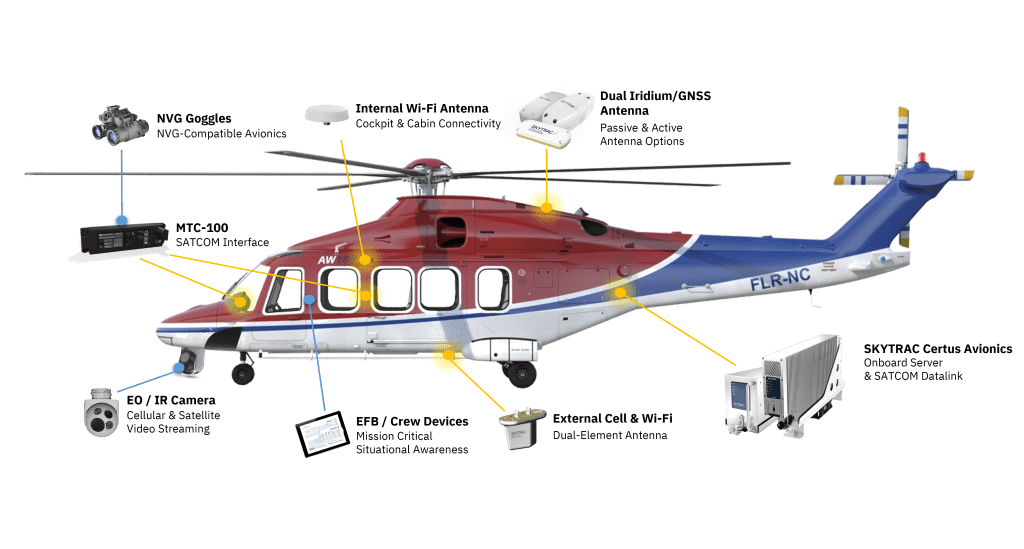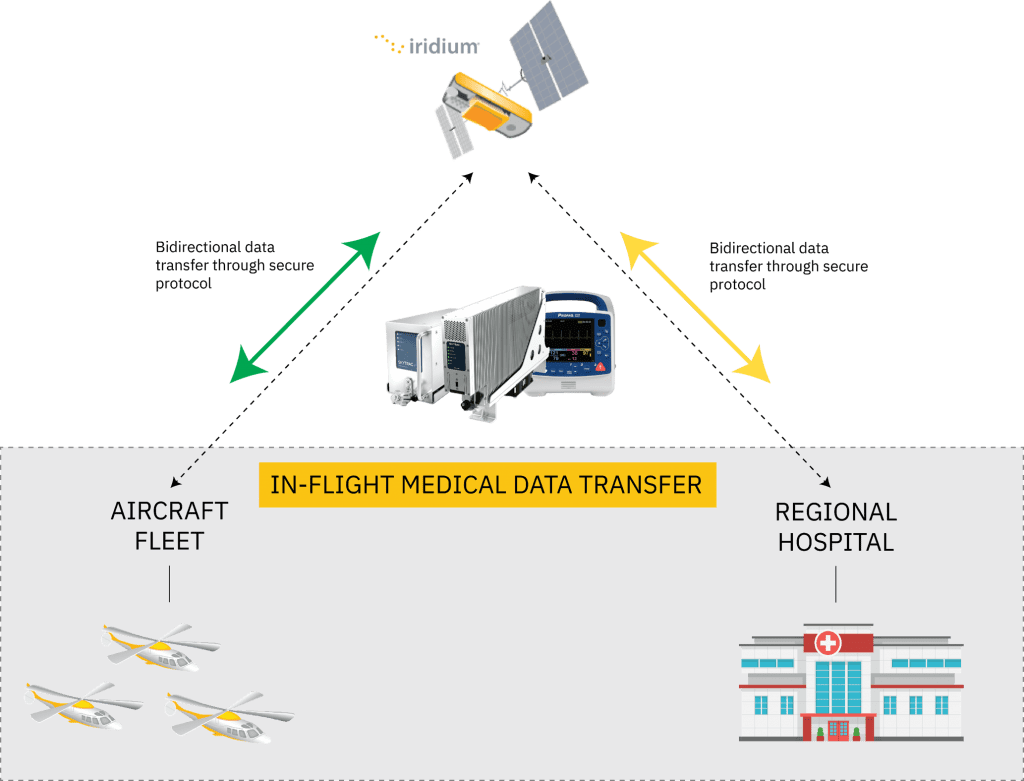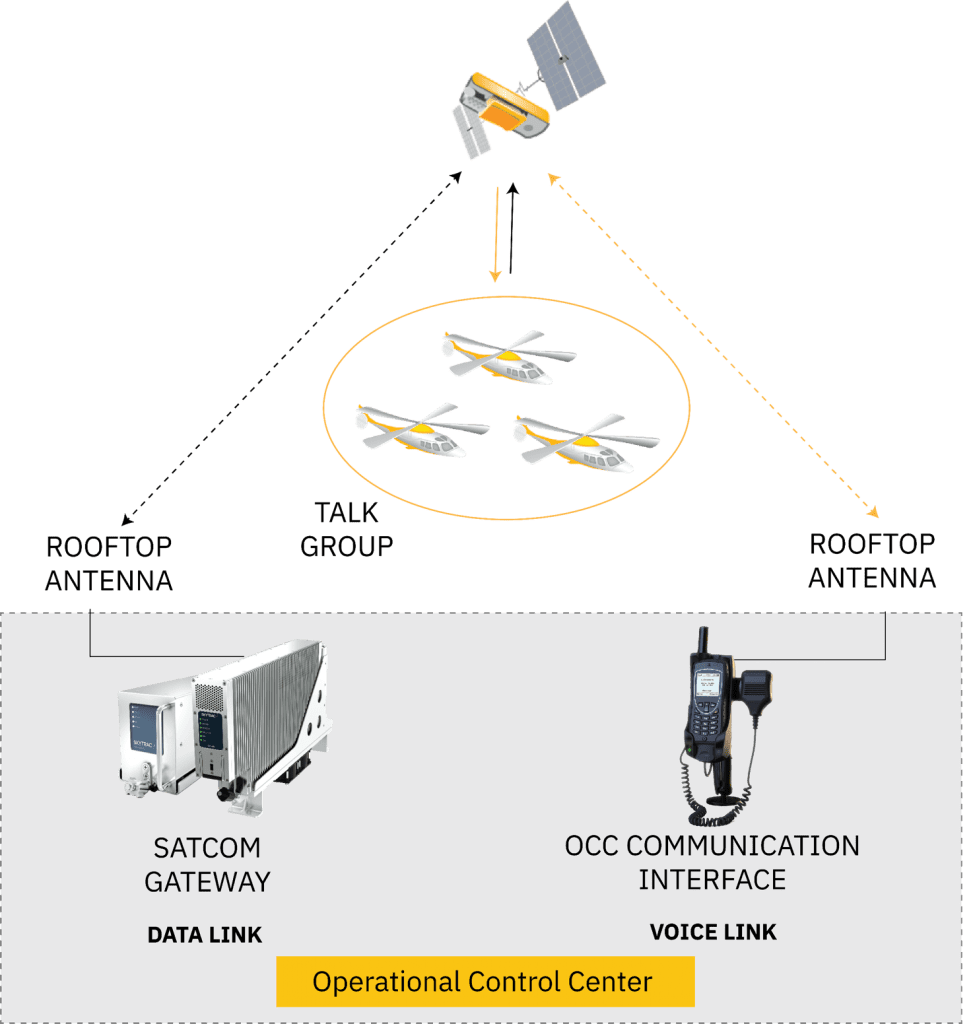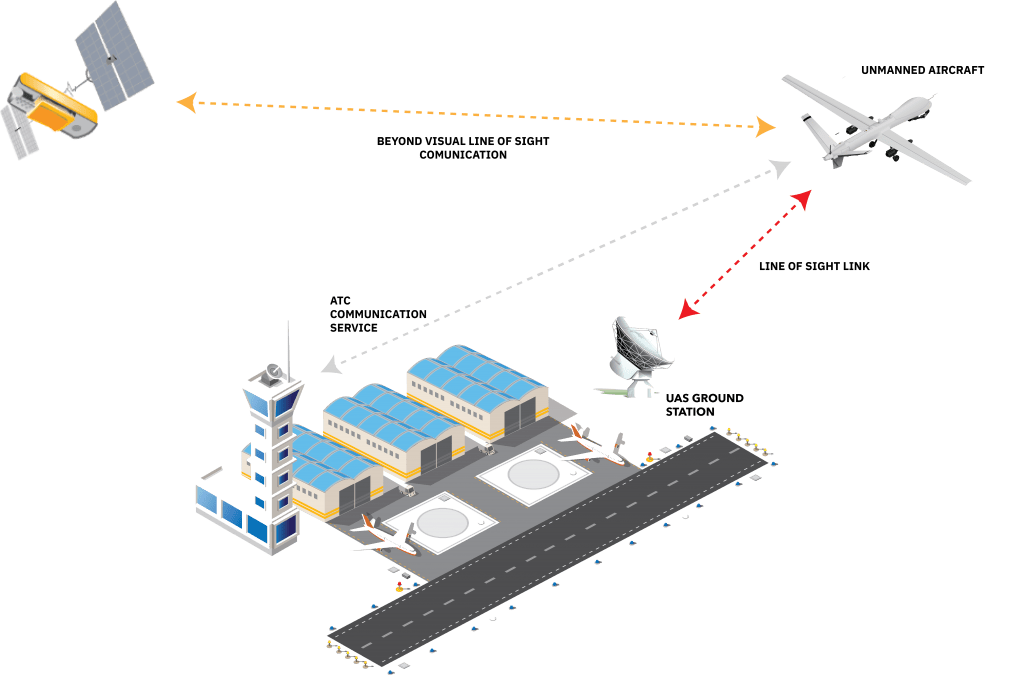Satellite communications can be applied differently within all segments of aviation. Commercial airline operators may require connectivity for Inflight Entertainment (IFE), credit card validation, and cockpit safety services. Air medical operators may improve patient outcomes with telemedicine and medical data transfer capabilities. Aerial firefighters can leverage real-time video transmission to report back to Ground Command Stations (GCS) with regards to quickly changing conditions. All these applications are ultimately to improve the safety for civilians. While both LEO and GEO networks may be suitable, operators also consider operational efficiencies within their respective lines of business to determine the best solution.
Table of Contents
Commercial Airline Applications

While GEO may be an appealing option to commercial aircraft for their bandwidth capabilities, such as for providing high speed internet browsing to multiple passengers at once, there are also benefits to supplementing costly GEO systems with powerful L-band capabilities in the cockpit. With L-band, connectivity can be guaranteed globally, providing an effective safety mechanism for pilots and flight operations.
Global Aeronautical Distress and Safety System (GADSS)
One example is GADSS, which requires commercial airlines to send position reports throughout the globe when distress scenarios are detected. For polar flights, LEO constellations such as Iridium NEXT can meet the requirement due to its globally available connectivity. By supplementing the cockpit with an Iridium L-band Satcom terminal, airlines can satisfy position tracking requirements around the world.
Voice and Text Communications
L-band Satcom can also be used for low-latency communication with Air Traffic Control (ATC) as a secondary communications system to VHF and HF radio systems to provide guaranteed global voice communications.
Electronic Flight Bag Automation
Airlines, business jets, and helicopters can ensure cockpit connectivity with L-band bandwidth to automatically transfer data used in electronic flight bags and other process automation tasks. The truly global connectivity of L-band ensures aircraft data is effectively routed to the right sources, under any conditions.
Weather to the Cockpit
Pilots can enhance their situational awareness with moving, real-time weather maps. Commercial and cargo airlines rely on accurate, real-time weather to make safe flying decisions. For airlines flying in regions of extreme weather, guaranteed connectivity is a key resource for pilots and passenger safety.
Public Safety Applications

Figure 1. Critical components relying on Satcom on a modern SAR helicopter.
Public safety agencies rely on mission-critical capabilities to power their success. Law enforcement, search and rescue (SAR), aerial firefighting, and emergency medical service (EMS) operators all leverage Satcom connectivity for a variety of applications. With reliability and resiliency being a chief concern.
Public safety agencies are also typical of mixed-fleet operators. These operators generally have both fixed-wing and helicopter assets. For fixed-wing aircraft, larger GEO systems are not an issue due the larger airframes. For helicopters, however, larger GEO systems have challenging to adapt due to size and weight constraints. Additionally, rotor shadow effects, illustrated in Figure 2, can greatly reduce potential bandwidth due to signal attenuation.
With multi-satellite L-band constellations such as Iridium NEXT, rotor shadow effects are largely eliminated due to the ability for LEO antennas to connect with satellites low on the horizon.
As technology continues to evolve, operational reliance on data will require enhanced connectivity. Remaining connected will become a priority to users, and reliable, weather-proof connectivity will pace industry adoption rates of LEO satellite connectivity.
Law Enforcement
Law enforcement agencies rely on reliable satellite connectivity for applications including live video streaming for surveillance, satellite Push-to-Talk (PTT), and fleet/ position tracking. Additionally, operators equipped with flight data monitoring (FDM) can benefit from automated post-flight downloading, saving valuable technician time.
With the advent of technologies like AnsuR’s ASMIRA, which enables powerful video compression to reduce the amount of data usage, L-band video streaming has recently generated considerable interest.
Law enforcement operators have already started to make the transition to L-band networks, and interest from the community has greatly increased since Iridium Certus became a viable solution.
In addition to surveillance, Law Enforcement operators are also leveraging satellite Push-to-Talk (PTT) capabilities to enable inter-fleet communications over long distances.
Aerial Firefighting
As aerial firefighting technologies advance and firefighting seasons become more pronounced, operators must find new ways to effectively combat wildfires. Aerial firefighting aircraft also require connectivity and communication technology when flying in extremely smokey conditions. L-band LEO satellites are the most resilient against these kinds of interference patterns and are preferable to operators seeking reliability under less than ideal circumstances.
Equipping fleets with live video transmission capabilities, whether with GEO or LEO Satcom, can provide useful insights to command and control on how fires are advancing, providing valuable strategic insights. With the advent of artificial intelligence and sensor fusion, multiple sensors and video feeds can now be integrated to provide detailed, layered insights with low latency. This data is critical to command-and-control centers and can help them make data-driven decisions in real-time to reduce risk while combating wildfires. Previously reserved to GEO networks, live video streaming is now possible through more efficient LEO networks like Iridium NEXT.
Air Medical
One of the operations most impacted by newer, lighter Satcom networks are medevac operators. Previously restricted due to considerable SWaP restrictions, medevac operators are now able to outfit their fleets with smaller, lighter LEO systems capable of providing broadband throughout at up to 704 Kbps. These new broadband capabilities enable telemedicine applications, medical data transfer capabilities, and more.
Medical data transfer in particular is a useful capability that enables operators to send onboard patient vitals directly to receiving hospitals in real-time. Additionally, transport physicians can also view patient data live through secure, remote servers to make critical care decisions. This capability was previously limited to onboard paramedics and flight nurses relaying patient vitals by radio or phone. Now, with medical data transfer and telemedicine connectivity, the in-air and on-ground medical staff can work together more effectively.

Figure 2. Transmission of medical data through LEO (Iridium) network.
Military and Government Applications
For military and government operators that rely on guaranteed connectivity for effective communications, the choice between GEO and LEO depends on the use case.
For governments that rely on global connectivity, LEO is often the primary choice. Since the start of the Iridium constellation, Iridium’s primary contracts were from the United States military needing secure, high-reliability connectivity. With L-band networks, fleet tracking, voice communications, text messaging, and satellite Push-to-Talk (PTT) were all capabilities enabled through the global L-band networks.

Figure 3. Encrypted Satellite Push-to-Talk through LEO (Iridium) network.
Unmanned Aviation Applications
Unmanned aviation is currently the fastest growing segment in aviation and certain operations depend on reliable connectivity. Unmanned aerial vehicles (UAVs), which rely on Satcom for Beyond-Line-of-Sight (BLOS) and Command-and- Control (C2) applications. GEO or LEO Satcom can be used.
However, larger Satcom systems, such as those that utilize GEO networks, cannot be used on small to medium UAVs due to size and weight constraints. Smaller UAVs, often employed by industry, will be better suited to both midband and broadband L-band networks centered around L-band connectivity. These networks can enable BLOS flights and Command-and-Control applications under limited bandwidth within a variety of industries.
For operators who seek to conduct missions around the world, L-band LEO networks provide the best opportunity for guaranteed connectivity. Additionally, the low latency of LEO constellations ensure that operators have minimal delays responsivity when updating UAV flight parameters.
For some segments of aviation, LEO satellite connectivity is really the only feasible option, such as for small to mid-size unmanned aerial vehicles and rotorcraft operators. For other segments, LEO satellite connectivity can function as a critical secondary system to improve pilot situational awareness and thus safety of your operations.
LEO satellite connectivity is applicable to all segments of aviation while GEO satellite connectivity is better for high bandwidth/throughput applications.

Figure 4. Satcom Beyond Line of Sight (BLOS) communications with UAV.
Conclusion and Considerations
LEO constellations meet aviation’s need for resilient, truly global connectivity.
Overall, both GEO and LEO constellations offer unique value to the aviation industry. Traditional GEO networks are now being challenged with the new and exciting capabilities of broadband LEO satellites.
For very bandwidth intensive applications that don’t require low latency, GEO networks will continue to remain the operator’s choice. However, for mission-oriented fleets needing connectivity for surveillance imagery with video compression technologies, AI and sensor fusion, VIP internet, and Command-and-Control (C2) applications, LEO networks are viable and cost-effective.
For operators that conduct missions around the globe, globally available LEO networks such as the Iridium NEXT constellation may be the best consideration from an operational standpoint.
LEO constellation networks provide the resiliency needed for demanding operations such as aerial firefighting, offshore oil and gas, and military missions. They are also better suited for new and rapidly growing segments of aviation such as unmanned aviation. With this, LEO constellations are able to offer unique benefits to aircraft operators around the globe.
Contact us
To learn more about SKYTRAC Iridium Certus terminals for aviation, please contact sales@skytrac.ca.
SKYTRAC’s #SatcomSeries focuses on the evolution of satellite communication technology and its application for the aviation industry. Follow along for more articles on the topic.
Get in Touch
Speak with a connectivity expert today. We are eager to discuss your business needs.

